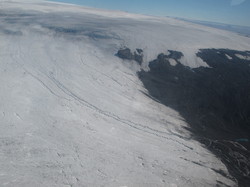Gas concentrations in the Hofsjökull ice cave
The Icelandic Meteorological Office (IMO) recently warned of the dangers of gas pollution and roof collapse in a recently discovered ice cave in Blágnípujökull, a SW outlet glacier from the Hofsjökull ice cap in Central Iceland. The warning was partly based on handheld gas-sensor measurements made on February 3. On February 17 at 13:30 another group visited the cave and voluntarily conducted the same kind of measurements using two Gas-Pro handheld gas sensors.
The concentration of hydrogen sulfide (H2S) was zero outside the cave but soon rose to levels above 20 ppm inside, the level at which some people stop smelling the gas. Still higher values were then measured deeper into the cave, reaching the highly hazardous values of 120-183 ppm within a couple of minutes of walking into the cave. The group turned back at this point and did not visit the innermost part of the cave. The above mentioned gas measurements were not conducted by IMO personnel; but as a general rule in IMO fieldwork, scientists and technicians equipped with gas masks and eye protection immediately evacuate when levels of H2S rise above 100 ppm. Above 100 ppm of H2S, the sense of smell can disappear within minutes and damage may be done to the eyes and throat. No further measurements have been made on the gas concentrations in the Blágnípujökull cave, or other geothermal caves in Iceland, and there may be even higher levels than those already reported. Oxygen was measured at normal levels, so there is no evidence of carbon dioxide (CO2) accumulation, but this was not measured on these devices. Sulfur dioxide (SO2) was not detected in the cave.
An addition hazard is the potential for roof collapse. During another visit in the past week, an ice block sized 2*4*0.4 m was seen to have collapsed from a side wall near the entrance of the cave.




